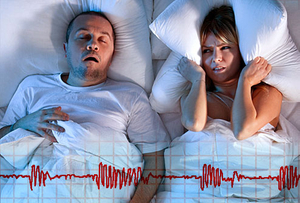- 1620 San Carlos Ave
San Carlos, CA 94070 - P: (650) 620-9675
- F: (650) 620-9681

Resources
Sleep Apnea: How Orthodontics Can Help

Background
Obstructive Sleep Apnea (OSA) involves partial or complete blockage of airway followed by a reduction of blood oxygen level while sleeping, and arousal from sleep. OSA has large negative health, behavioral, and social implications. Many of health complications of OSA have been recently discovered. Poor oxygen flow as a result of OSA has been linked to heart disease, stroke, and diabetes. Poor night time sleep quality affects cognitive function during the day, leading to reduced productivity, and motor vehicle accidents. As much as 90% of OSA patients in the US remain undiagnosed.
Signs to Watch for
The most easily-recognized sign is snoring while sleeping. The loudness of snoring is particularly alarming. One of the reasons OSA goes undiagnosed, is that most snorers are unaware of their snoring unless told by a bed partner. OSA patients also frequently stop breathing while sleeping for a short while and abruptly wake up and start breathing again. In children, symptoms may show up as poor performance in school, and hyperactive behavior. Children with OSA could be misdiagnosed as having ADHD.
Diagnosis
The golden standard for diagnosis of OSA is a sleep study, known as polysomnogram. The study can be done in a sleep lab or at home. The sleep study measures the number of episodes of complete and partial cessation of airflow (AHI index) as well as blood's oxygen levels. The results of sleep study must be interpreted by a medical doctor and the diagnosis is arrived at via analysis of the indices.
Background
My practice philosophy is to offer phase I treatment only when I know the child will receive significant benefits from early treatment. I keep my phase I treatment conservative and short, correcting problems which studies indicate, if left alone, can become bigger problems by the time the child is a teenager. I make sure that my patient's parents are fully educated on the objectives of phase I treatment and the future need for phase II treatment.
Causes
The most common cause of a crowded airway is obesity. The increased fatty tissue around the throat narrows the airway, making it more likely to get blocked in a supine sleeping position. However, many slender individuals may have OSA. In children, enlarged tonsils can be the cause of airway blockage. The biggest culprit in crowding the airway, however, is the tongue. When we sleep, the muscles relax, and the tongue falls back, partially or completely blocking the airway.
Treatment
The first line of treatment in mild-moderate OSA is lifestyle change such as weight loss, and reduction of alcohol intake before bedtime. Positional changes such as sleeping elevated with multiple pillows can help. In cases of diagnosed OSA, a cPAP (continuous Positive Air Pressure) is to be worn at night. The cPAP is very effective in reducing OSA symptoms, however, can be difficult to tolerate. In children, removal of enlarged tonsils may be indicated to open the airway. In moderate OSA cases, oral appliances have been effective as a substitute for cPAP. Oral appliances are worn at night and position the lower jaw forward which moves the tongue forward out of the airway. In severe adult OSA cases, surgical treatment may be recommended. Surgical advancement of jaws in a forward direction has been shown to be the most effective surgical treatment for OSA. Forward repositioning of the lower jaw, positions the tongue in a more forward position, and clears the airway.
Orthodontics
Since the cause of OSA is a blocked oropharyngeal airway, treatment is directed toward increasing the airway volume. Maxillary expansion has been shown to be effective by widening the floor of the nasal cavity. Maxillary expansion is particularly effective in children because of the patency of the palatal sutures. Expansion is done via a custom expander appliance which is typically cemented on two maxillary molars. The appliance has an expansion screw in the center which is activated by a key. The orthodontist will give parents instructions on how to activate the expander at home by turning the key. The expander is designed to be easily tolerated by children with minimal discomfort. In addition to expansion, bite corrector (functional) appliances can be used in children to not only correct the bite, but also help with OSA by positioning the lower jaw forward. These custom appliances can be fixed (cemented), or removable.
In adults with OSA who cannot tolerate the cPAP, oral appliances may be a good option. The orthodontist can take the steps for appliance fabrication and delivery. Long-term use of oral appliances can cause changes in the bite. Thus, orthodontic monitoring is an important aspect of oral appliance therapy.
In severe adult cases, where orthognathic (jaw corrective) surgery is indicated, the pre-surgical preparation requires orthodontic treatment. The pre-surgical stage is typically about 1 year of full orthodontic treatment to align the teeth, and set up the bite for surgery. Post-surgical analyses of the airway have shown significant increase in airway volume, and reduction of OSA symptoms. Surgical treatment can bring life-altering changes for certain patients.
In all sleep apnea cases, close monitoring by a sleep specialist medical doctor should accompany orthodontic treatment.





